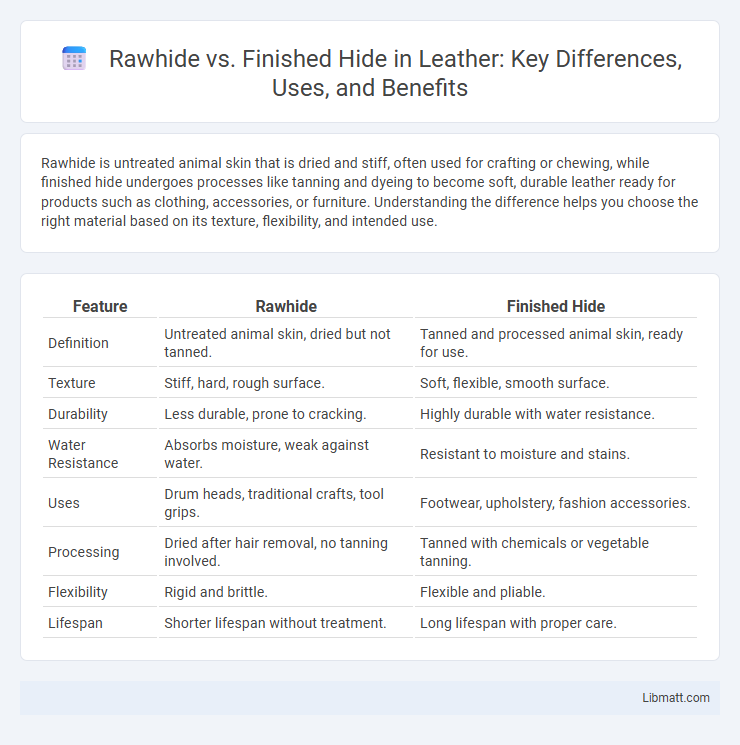Rawhide is untreated animal skin that is dried and stiff, often used for crafting or chewing, while finished hide undergoes processes like tanning and dyeing to become soft, durable leather ready for products such as clothing, accessories, or furniture. Understanding the difference helps you choose the right material based on its texture, flexibility, and intended use.
Table of Comparison
| Feature | Rawhide | Finished Hide |
|---|---|---|
| Definition | Untreated animal skin, dried but not tanned. | Tanned and processed animal skin, ready for use. |
| Texture | Stiff, hard, rough surface. | Soft, flexible, smooth surface. |
| Durability | Less durable, prone to cracking. | Highly durable with water resistance. |
| Water Resistance | Absorbs moisture, weak against water. | Resistant to moisture and stains. |
| Uses | Drum heads, traditional crafts, tool grips. | Footwear, upholstery, fashion accessories. |
| Processing | Dried after hair removal, no tanning involved. | Tanned with chemicals or vegetable tanning. |
| Flexibility | Rigid and brittle. | Flexible and pliable. |
| Lifespan | Shorter lifespan without treatment. | Long lifespan with proper care. |
Introduction to Rawhide and Finished Hide
Rawhide is untreated animal hide that retains its natural moisture and flexibility, commonly used in craftwork and traditional tools. Finished hide undergoes processing such as tanning, dyeing, and conditioning, making it durable, pliable, and suitable for products like leather goods and upholstery. Understanding the differences helps you choose the right material for your project's durability and appearance needs.
Understanding Rawhide: Definition and Characteristics
Rawhide is animal hide that has been cleaned but not tanned, maintaining its natural, stiff, and brittle texture. Unlike finished hides, rawhide is more susceptible to moisture and can become soft or moldy without proper care. Understanding rawhide's untreated nature helps you choose the right material for crafts or tools requiring durability and rigidity.
What is Finished Hide? Key Features Explained
Finished hide refers to leather that has undergone processes like tanning, dyeing, and surface treatment to enhance durability, appearance, and texture. Key features include a smooth, uniform surface, resistance to moisture and stains, and increased flexibility compared to rawhide. Your choice of finished hide ensures a refined, polished look ideal for furniture, accessories, and apparel.
Rawhide Production Process
Rawhide production involves soaking animal hides in water to remove blood and dirt, followed by stretching and drying without tanning, which preserves the natural texture and strength. Unlike finished hide, rawhide remains stiff and porous, making it ideal for crafting durable items like drumheads and chew toys. Understanding this process helps you appreciate rawhide's unique qualities and suitability for specialized applications.
How Finished Hide is Made
Finished hide is created through a meticulous tanning process that transforms rawhide, which is simply dried animal skin, into a durable and flexible material. This process involves soaking the rawhide in tannins or chemicals to stabilize the fibers, followed by drying, stretching, and sometimes dyeing to achieve the desired texture and color. Your finished hide is then suitable for crafting high-quality leather goods due to its enhanced strength, suppleness, and aesthetic appeal.
Durability: Rawhide vs Finished Hide
Rawhide is less durable than finished hide due to its untreated, stiff texture that is prone to cracking and wear over time. Finished hide undergoes tanning and conditioning processes that enhance moisture resistance, flexibility, and overall strength, significantly increasing its lifespan. Finished hide is ideal for applications requiring long-term durability, while rawhide is better suited for temporary or decorative uses.
Common Uses and Applications
Rawhide is commonly used for crafting sturdy items like drum heads, dog chews, and traditional tools due to its toughness and rigidity before tanning. Finished hide undergoes treatment and conditioning, making it ideal for flexible applications such as leather upholstery, clothing, footwear, and accessories. Your choice between rawhide and finished hide depends on whether you need durability in its natural form or a supple material suitable for refined products.
Pros and Cons of Rawhide
Rawhide offers superior durability and rigidity compared to finished hide, making it ideal for crafting tough goods like drum heads and dog chews; however, its untreated surface makes it more susceptible to moisture damage and requires longer curing time. The porosity of rawhide allows it to absorb oils and finishes better, but it can become stiff and brittle if not maintained properly. Finished hide, while less durable, provides enhanced flexibility, water resistance, and a refined appearance, suitable for high-end leather goods.
Advantages and Disadvantages of Finished Hide
Finished hide offers enhanced durability and water resistance compared to rawhide, making it ideal for products like upholstery, footwear, and accessories that require long-lasting wear. The tanning and finishing processes give finished hide a smoother texture and more aesthetic appeal, but these treatments reduce breathability and can increase cost. Your choice depends on whether you prioritize toughness and visual quality over natural texture and lower expense.
Choosing Between Rawhide and Finished Hide
Choosing between rawhide and finished hide depends on your intended use, as rawhide offers natural durability and flexibility before processing, while finished hide provides enhanced strength, smoothness, and resistance to moisture. Rawhide is ideal for crafting projects requiring a natural, untreated material, whereas finished hide suits applications needing a polished, long-lasting surface such as leather goods or upholstery. Understanding these differences ensures you select the right material to meet your specific needs and desired aesthetic.
Rawhide vs finished hide Infographic

 libmatt.com
libmatt.com